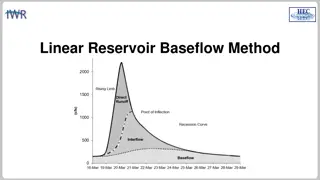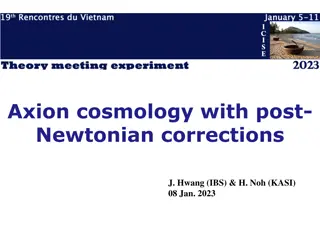Projection Methods in Chemistry: A Survey of Linear and Nonlinear Techniques
Visualization and interpretation of high-dimensional data structures in chemistry can be achieved through projection techniques. Linear projection methods like PCA and Pursuit Projection allow for dimensionality reduction and clustering tendency exploration. The Intent Pursuit Projection (PP) technique introduced by Roy and Kruskal optimizes a projection index to reveal interesting low-dimensional linear projections. The Shannon entropy-based projection index, as suggested by Huber, Jones, and Sibson, can be uniquely minimized by the standard normal density.
Download Presentation

Please find below an Image/Link to download the presentation.
The content on the website is provided AS IS for your information and personal use only. It may not be sold, licensed, or shared on other websites without obtaining consent from the author.If you encounter any issues during the download, it is possible that the publisher has removed the file from their server.
You are allowed to download the files provided on this website for personal or commercial use, subject to the condition that they are used lawfully. All files are the property of their respective owners.
The content on the website is provided AS IS for your information and personal use only. It may not be sold, licensed, or shared on other websites without obtaining consent from the author.
E N D
Presentation Transcript
Projection methods in chemistry M. Daszykowski, B. Walczak, D.L. Massart* Chemometrics and Intelligent Laboratory Systems 65 (2003) 97 112 By: Atefe Malek.khatabi Autumn Autumn2011 2011
Visualization of a data set structure is one of the most challenging goals in data mining. In this paper, a survey of different projection techniques, linear and nonlinear, is given. Compression is possible due to the two reasons: often many variables are highly correlated their variance is smaller than the measurement noise. visualization and interpretation of high-dimensional data set structure carry out with clustering of data or data reduction.
Linear projection methods: principal component analysis PCA Pursuit projection PP This type of analysis (PCA) has been first proposed by Pearson and fully developed by Hoteling. PCA allows projection of multidimensional data onto few orthogonal features, called principal components (PCs), constructed as linear combination of original variables to maximize description of the data variance. The dimensionality reduction techniques do not always reveal clustering tendency of the data. The intent pursuit projection (PP) is to reveal the sharpest low-dimensional projection to find clusters.
PP was originally introduced by Roy and Kruskal. PP is an unsupervised technique that searches interesting low dimensional linear projections of a high-dimensional data by optimizing a certain objective function called projection index (PI). The goal of data mining (i.e. revealing data clustering tendency) should be translated into a numerical index, being a functional of the projected data distribution. This function should change continuously with the parameters defining the projection and have a large value when the projected distribution is defined to be interesting and small otherwise. In this paper, the described algorithm is used with two different projection indices
Entropy: Huber and Jones and Sibson suggested PI based on the Shannon entropy: where f(x) is a density estimate of the projected data. This index is uniquely minimized by the standard normal density. The required density estimate, f(x) can be calculated as a sum of m individual density functions (kernels), generated at any position x by each projected object:
where h is the so-called smoothing parameter (band width), k is a kernel function, t1, t2,. . ., tm denote coordinates of the projected objects. where r parameter is estimated from the data, usually by sample standard deviation, and m is the number of data objects.
Yenyukov index Q. According to the nearest neighbour approach proposed by Yenyukov , the clustering tendency of data can be judged based on the ratio of the mean of all inter-objects distances, D, and the average nearest neighbour distance, d, i.e.: For clustered data, Q has a large value, whereas for less clustered ones Q is small.
Nonlinear projection methods: Kohonen self organization map SOM Generative Topographic Maps GTM Sammon projection Auto-associative feed-forward networks Kohonen self-organizing maps (SOM) A Kohonen neural network is an iterative technique used to map multivariate data. The network is able to learn and display the topology of the data. When each sample is represented by n measurements (n>3), by a two or three-dimensional representation of the measurement space we can to visualize the relative position of the data points in n-space.
To compare with PCA , SOM didnt need to data preprocessing. A Kohonen neural network maps multivariate data onto a layer of neurons arranged in a two dimensional grid. Each neuron in the grid has a weight associated with it, which is a vector of the same dimension as the pattern vectors comprising the data set. Each input Each neuron m m m weight level Position of neuron by excited Xs
the number of neurons used should be between 33% and 50% of the number of input vector in the training set. The components of each weight vector are assigned random numbers. where wi(t + 1) is the ith weight vector for the next iteration, wi(t) is the ith weight vector for the current iteration, is the learning rate function, is the neighborhood function, and xi is the sample vector currently passed to the network. The learning rate is chosen by the user as a positive real number less than 1. The decrease of the neighborhood can be scaled to be linear with time, thereby reducing the number of neurons around the winner being adjusted during each epoch.
The control parameters include: the number of epochs (iterations), grid topology and size, the neighborhood function, the neighborhood adjustment factor, the learning rate function Top map
218 188 Raman spectra of six common household plastics 169 training set 19 prediction set 188
Generative Topographic Maps (GTM): Generative Topographic Mapping (GTM), introduced by Bishop et al. The aim of the GTM procedure is to model the distribution of data in an n- dimensional space x=[x1, x2,. . ., xn] in terms of a smaller number of latent variables, u=[u1, u2,. . ., uL].
Sammon projection: Sammon s algorithm maps the original space onto a low-dimensional projection space in such a way that the distances among the objects in the original space are being preserved as well as possible. where dij* is the distance between two objects i and j in the original space and dij defines the distance between those objects in the reduced space. The computational time is much longer than for SOM and for new samples it is not possible to compute their coordinates in the latent space where as SOM allow that.
Auto-associative feed-forward networks (BNN): For the first time auto-associative mapping was used by Ackley et al.
Feed-forward network is usually used in supervised settings. This type of neural network is also known as a bottleneck neural network (BNN), and in the literature is often referred as nonlinear PCA. Net training is equivalent with weights adjustment. Weights, initialized randomly, are adjusted in each iteration to minimize the sum of squared residuals between the desired and observed output. Once the net is trained, the outputs of the nonlinear nodes in the second hidden layer serve as data coordinates in reduced data space.
Results and discussion: Data sets: Data set 1 contains 536 NIR spectra of three creams with three different concentrations of an active drug. Data set 2 contains 83 NIR spectra collected in the spectral range of 1330 2352 nm for four different quality classes of polymer products. Data set 3 contains 159 variables and 576 objects. Objects are the products of Maillard reaction of mixtures of one sugar and one or two amino acids at constant pH = 3.
Results and discussion: data set 1 containing 701 variables can very efficiently be compressed by PCA to two significant PCs
the size and the color intensity of the node are proportional to the number of objects therein. The biggest node (1,1), i.e. contains 21 objects and the smallest nodes, (4,2) and (5,2) contain only one object each
SOM sammon PCA BNN
In case of Sammon projection, no real clustering tendency is observed by the Kohonen map the biggest nodes are in the corners of the map. Based on the content of Fig. 10 only, it is difficult to draw more conclusions. The results of BNN with two nodes in the bottleneck and seven nodes in mapping and de-mapping layer, respectively, reveal two classes, better separated than in SOM























